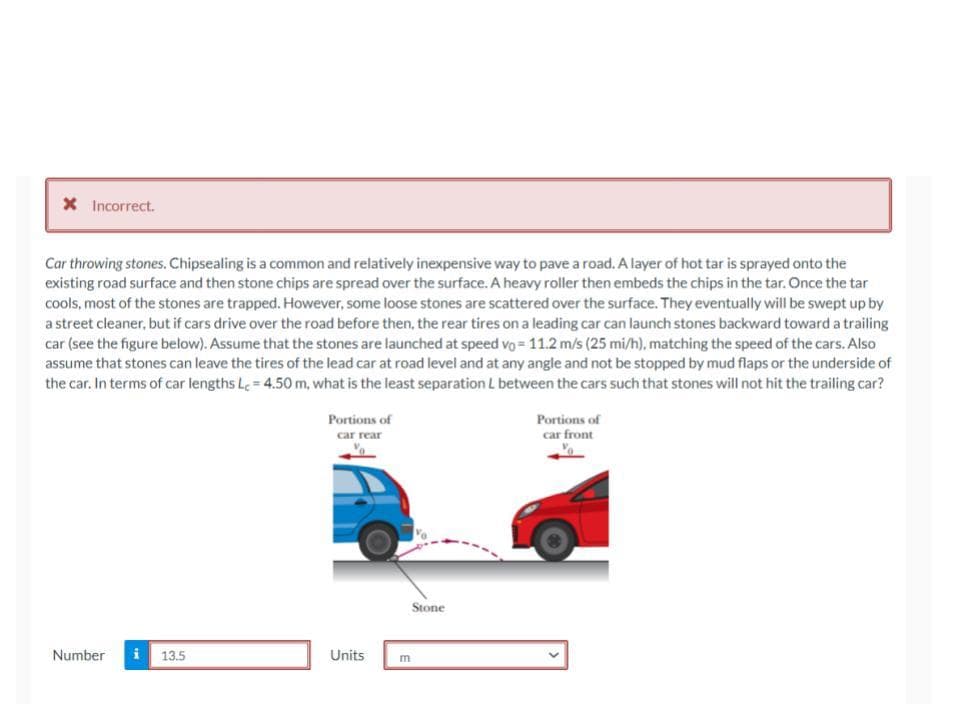Car throwing stones. Chipsealing is a common and relatively inexpensive way to pave a road. A layer of hot tar is sprayed onto the existing road surface and then stone chips are spread over the surface. A heavy roller then embeds the chips in the tar. Once the tar cools, most of the stones are trapped. However, some loose stones are scattered over the surface. They eventually will be swept up by a street cleaner, but if cars drive over the road before then, the rear tires on a leading car can launch stones backward toward a trailing car (see the figure below). Assume that the stones are launched at speed vo= 11.2 m/s (25 mi/h), matching the speed of the cars. Also assume that stones can leave the tires of the lead car at road level and at any angle and not be stopped by mud flaps or the underside of the car. In terms of car lengths Le = 4.50 m, what is the least separation L between the cars such that stones will not hit the trailing car? Number i 13.5 Portions of car rear Units Stone m Portions of car front
Car throwing stones. Chipsealing is a common and relatively inexpensive way to pave a road. A layer of hot tar is sprayed onto the existing road surface and then stone chips are spread over the surface. A heavy roller then embeds the chips in the tar. Once the tar cools, most of the stones are trapped. However, some loose stones are scattered over the surface. They eventually will be swept up by a street cleaner, but if cars drive over the road before then, the rear tires on a leading car can launch stones backward toward a trailing car (see the figure below). Assume that the stones are launched at speed vo= 11.2 m/s (25 mi/h), matching the speed of the cars. Also assume that stones can leave the tires of the lead car at road level and at any angle and not be stopped by mud flaps or the underside of the car. In terms of car lengths Le = 4.50 m, what is the least separation L between the cars such that stones will not hit the trailing car? Number i 13.5 Portions of car rear Units Stone m Portions of car front
Physics for Scientists and Engineers
10th Edition
ISBN:9781337553278
Author:Raymond A. Serway, John W. Jewett
Publisher:Raymond A. Serway, John W. Jewett
Chapter7: Energy Of A System
Section: Chapter Questions
Problem 13P: The tray dispenser in your cafeteria has broken and is not repairable. The custodian knows that you...
Related questions
Question

Transcribed Image Text:* Incorrect.
Car throwing stones. Chipsealing is a common and relatively inexpensive way to pave a road. A layer of hot tar is sprayed onto the
existing road surface and then stone chips are spread over the surface. A heavy roller then embeds the chips in the tar. Once the tar
cools, most of the stones are trapped. However, some loose stones are scattered over the surface. They eventually will be swept up by
a street cleaner, but if cars drive over the road before then, the rear tires on a leading car can launch stones backward toward a trailing
car (see the figure below). Assume that the stones are launched at speed vo= 11.2 m/s (25 mi/h), matching the speed of the cars. Also
assume that stones can leave the tires of the lead car at road level and at any angle and not be stopped by mud flaps or the underside of
the car. In terms of car lengths Lc=4.50 m, what is the least separation L between the cars such that stones will not hit the trailing car?
Number
13.5
Portions of
car rear
Units
Stone
E
Portions of
car front
Expert Solution
This question has been solved!
Explore an expertly crafted, step-by-step solution for a thorough understanding of key concepts.
This is a popular solution!
Trending now
This is a popular solution!
Step by step
Solved in 3 steps with 3 images

Knowledge Booster
Learn more about
Need a deep-dive on the concept behind this application? Look no further. Learn more about this topic, physics and related others by exploring similar questions and additional content below.Recommended textbooks for you

Physics for Scientists and Engineers
Physics
ISBN:
9781337553278
Author:
Raymond A. Serway, John W. Jewett
Publisher:
Cengage Learning

Physics for Scientists and Engineers with Modern …
Physics
ISBN:
9781337553292
Author:
Raymond A. Serway, John W. Jewett
Publisher:
Cengage Learning

Physics for Scientists and Engineers: Foundations…
Physics
ISBN:
9781133939146
Author:
Katz, Debora M.
Publisher:
Cengage Learning

Physics for Scientists and Engineers
Physics
ISBN:
9781337553278
Author:
Raymond A. Serway, John W. Jewett
Publisher:
Cengage Learning

Physics for Scientists and Engineers with Modern …
Physics
ISBN:
9781337553292
Author:
Raymond A. Serway, John W. Jewett
Publisher:
Cengage Learning

Physics for Scientists and Engineers: Foundations…
Physics
ISBN:
9781133939146
Author:
Katz, Debora M.
Publisher:
Cengage Learning

Principles of Physics: A Calculus-Based Text
Physics
ISBN:
9781133104261
Author:
Raymond A. Serway, John W. Jewett
Publisher:
Cengage Learning

Physics for Scientists and Engineers, Technology …
Physics
ISBN:
9781305116399
Author:
Raymond A. Serway, John W. Jewett
Publisher:
Cengage Learning

College Physics
Physics
ISBN:
9781938168000
Author:
Paul Peter Urone, Roger Hinrichs
Publisher:
OpenStax College